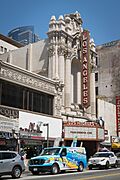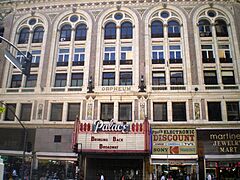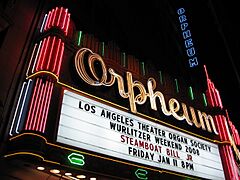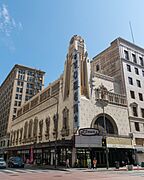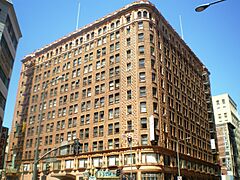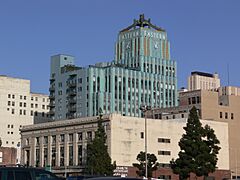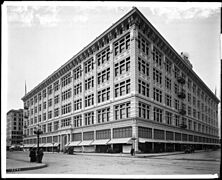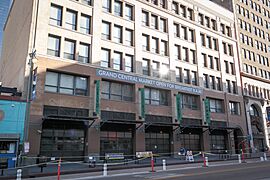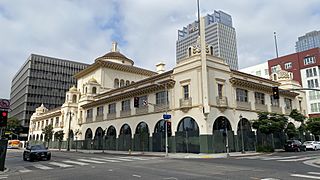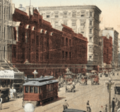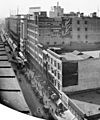Broadway (Los Angeles) facts for kids
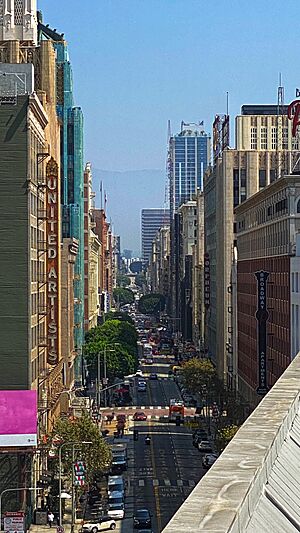
A view of Broadway looking north from 11th Street in 2020.
|
|
| Maintained by | Local jurisdictions |
|---|---|
| Length | 17.75 mi (28.57 km) |
| Location | Los Angeles County, California, United States |
| South end | Main Street in Carson |
| Major junctions |
|
| Northeast end | Mission Road in Lincoln Heights |
| Construction | |
| Inauguration | 1890 |
|
Broadway Theater and
Commercial District (NRHP) Broadway Theater and Entertainment District (City of Los Angeles) |
|

The famous Los Angeles Theatre on Broadway.
|
|
| Location | 300—849 S. Broadway Los Angeles, California |
| Architect | Multiple |
| Architectural style | Early Commercial, Classical Revival, Art Deco |
| NRHP reference No. | 79000484 |
| Significant dates | |
| Added to NRHP | May 9, 1979 |
| Boundary increase | April 12, 2002 |
Broadway is a major street that runs through Los Angeles County, California. A special part of this street, from 3rd to 9th Street, was once the main shopping and entertainment area of Los Angeles, especially in the early 1900s.
This area is so important that it's listed on the National Register of Historic Places as the Broadway Theater and Commercial District. It was the first and largest theater district in the country to be added to this list. This means it is protected as a special part of American history.
Route of Broadway
Broadway is a long street, stretching for almost 18 miles. It starts in the city of Carson and runs north through different neighborhoods like South Los Angeles.
It then enters the heart of Downtown Los Angeles, where you can find the famous historic theater district. After passing through the Civic Center and Chinatown, the street ends in a neighborhood called Lincoln Heights.
History of Broadway
How It All Started
Broadway is one of the oldest streets in Los Angeles. It was first planned in 1849 and was called Ford Street. In 1890, a part of the street was renamed Broadway, and it quickly became an important location.
To make the street longer, the city built the Broadway Tunnel in 1901. This tunnel went through a large hill and connected Broadway to other streets, helping the city grow. Over the years, bridges were built and other streets were renamed to become part of the long Broadway we know today.
A Center for Shopping and Fun
From the early 1900s until the 1950s, Broadway was the place to be in Los Angeles. It was the city's main center for shopping and entertainment. The street was lined with huge department stores and beautiful theaters.
Four of the biggest department stores on Broadway were so large that their combined space was massive. These stores were:
- The Broadway
- Bullock's
- May Co.
- J. W. Robinson's
These stores sold everything you could imagine and attracted shoppers from all over Southern California.
Changes Over Time
By the 1950s, things started to change. The main shopping area moved to other parts of the city, and Hollywood became the new center for theaters. Many of the grand department stores on Broadway closed down in the 1970s and 1980s.
The area then became a popular shopping district for the city's Latino community. In recent years, many new shops have opened, especially stores selling sneakers and modern clothing. This has brought new energy to the street.
Bringing Broadway Back
In 2008, the city of Los Angeles started a project called "Bringing Back Broadway." The goal was to make the historic street lively and beautiful again. The project included making sidewalks wider for people to walk, adding plants and benches, and restoring some of the old buildings.
This effort helped to preserve the street's amazing history while making it a better place for people to visit and enjoy today.
Famous Landmarks on Broadway
Broadway is famous for its incredible buildings, especially its historic theaters. Many of these were "movie palaces," which were large, fancy theaters built in the 1920s and 1930s.
Historic Theaters
-
The Los Angeles Theatre is known for its beautiful and fancy design.
-
The Orpheum Theatre is still a popular place for concerts and events.
-
The Tower Theatre was the first theater in Los Angeles designed for movies with sound. It is now an Apple Store.
-
The State Theatre opened in 1921 and could seat almost 2,500 people.
Other Famous Buildings
-
The Eastern Columbia Building is famous for its beautiful blue-green color and clock tower.
-
The May Company Building was once a huge department store.
-
The Homer Laughlin Building has been home to the Grand Central Market since 1917, a popular food hall.
-
The Herald Examiner Building was designed by famous architect Julia Morgan.
Public Transportation
It's easy to get to Broadway using public transportation. The Los Angeles Metro Rail has a station called Historic Broadway station, which is served by the A and E Lines. These trains can take you to places like Santa Monica, Long Beach, and Pasadena.
Several bus lines also run along or near Broadway, including the Metro J Line and Metro Local route 45. This makes it simple for people to visit the historic street without a car.
See also
 In Spanish: Broadway (Los Ángeles) para niños
In Spanish: Broadway (Los Ángeles) para niños
- Broadway Theater District (Los Angeles)
- List of contributing properties in the Broadway Theater and Commercial District
Images for kids



